Container Transport
Page 67

If you've noticed an error in this article please click here to report it so we can fix it.
by Roger Howell
Manchester thoughts
FIRST reports have been received of the paper given by Mr. R. S. F. Edwards, general manager of the Mersey Docks and Harbour Board to the 2nd International Container Services and Equipment Exposition at Baltimore held early last week.
Mr. Edwards stressed that with nearly onethird of the entire British population living and working within 100 miles of Merseyside it appeared that potential container operators did not appreciate the value of this British market. He commented: "As a port we are the only 'sales force' for this market and our recent establishment of a United States office in New York, and also introduction of advertising campaigns, result from the need to impress upon people the advantages to be gained by using present and future container facilities at Liverpool."
Looking further ahead. Mr. Edwards expressed opinion on the land-bridge principle, stating that the ultimate container development would be the extension and consolidation of genuine through-container services with complete integration into an international network of routes, on which the existing major ports would be the key links. Mr. Edwards quoted the present 30 days' duration of a fast freighter voyage from Japan to Hamburg. A container service would involve 21 days being routed via the American land-mass, the Atlantic and the UK. Emphasis had to be placed on the development of an efficient distribution Freightliner network across Britain which would ensure delivery of goods from Liverpool to the Western European hinterland within two days, rail and crosschannel services being used.
Mr. Edwards' forecast concerning a UK landbridge is particularly noteworthy. Certainly it would be to Merseyside's advantage if a proportion of its traffic was destined for the Continent, or was of Continental origin. To be taken into account, however, are the comparative costs of, say, direct USA/Continental operations with transhipment routine, whether of containers or conventional cargo, which generally add to charges even if only through profit margins of the several operators involved.
Scandinavian traffic might be a more inviting proposition. Several east coast ports, and Hull in particular, are already geared up for Scandinavian operations. Also, by the time relevant traffic flows have become sufficiently develop • ed. the Lancashire-Yorkshire motorway system should be complete.
High-speed terminal EXTENSIVE new facilities have been provided at the Port of Manchester in readiness for this week's inauguration of the cellular container ship service to Montreal, The Manchester Challenge is shortly to be joined by the Manchester Courage and the Manchester Concorde so that there will soon be a year-round weekly service by vessels designed to navigate the St. Lawrence winter ice. The Manchester Challenge carries up to 500 20ft containers, all under deck. Some of the containers on the first sailing had been brought from as far afield as Italy and Scandinavia in order to enjoy the accelerated service which will give a 14-day link between Manchester and Vancouver.
Hauliers using the new container terminal at Manchester Docks have been impressed by the swiftness of the routine. Last Friday one driver told a Commercial Motor representative that inside an hour from entering the dock gates he was back on the road again. This included following the signs that lead to the actual terminal, waiting in the vehicle queue, weighing, documentation, off-loading and return to the street.
A landmark for the container berth is the huge 430-ton Stothert and Pitt transporter crane of 25-ton lifting capacity. There is a five-acre marshalling yard which is connected to the crane by Clark 512 straddle carriers that can stack containers three high. Six 100ft towers provide floodlighting for night working.
A certain amount of vehicle queueing is inevitable but last Friday it was averaging under the half-hour. The reporting by the driver, weighing, checking of documents and off-loading was a matter of little more than five minutes.
Expansion A NEW container production line, costing approximately E250,000 commenced operation at Crane Fruehauf's North Walsham factory this week, virtually doubling capacity. Double shift working has been in operation at North Walsham since earlier this year and will continue to operate, hence enabling the group to meet both home and overseas demand for the foreseeable future.
New berth THE FIRST vessel to use the British Transport Docks Board's new deep-water container berth at Southampton opened recently was the my Teniers owned by the Compagnie Maritime Beige.
The Teniers was en route from Antwerp to New York and from now on Southampton will have a weekly sailing worked into MI6's European /North American service.
Although American opinion tends towards concentration of container activities in a few major ports. European developments are now becoming increasingly widespread to suit the short-haul nature of the traffic flows. British exporters' service will benefit if more European operators are prepared to make calls at such ports at start of their trans-Atlantic runs.
Ports and terminals
A BRISK demand exists for stand space at the Ports and Terminals '69 Exhibition which will be held at Belle Vue, Manchester, April 14-18, says the organizer, Maclean Hunter Ltd. So far reservations have been made for over 70 exhibitors, and booked stand space covers more than 5.000 sq.yd.
A three-day conference will be held in conjunction with the exhibition and it is expected that papers will be given by several prominent transport men. Conference chairman will be Sir Alexander Glen, chairman of H. Clarkson and Co.
Harwich/Rotterdam service increased BR has announced that the present threetimes-weekly sailing on the Harwich /Rotterdam container service operated with the my isle of Ely will be increased to daily frequency in December with the introduction of the my Damburgh owned by the Zeeland Steamship Co.




























































































































































